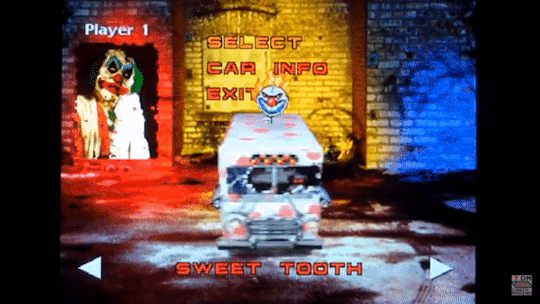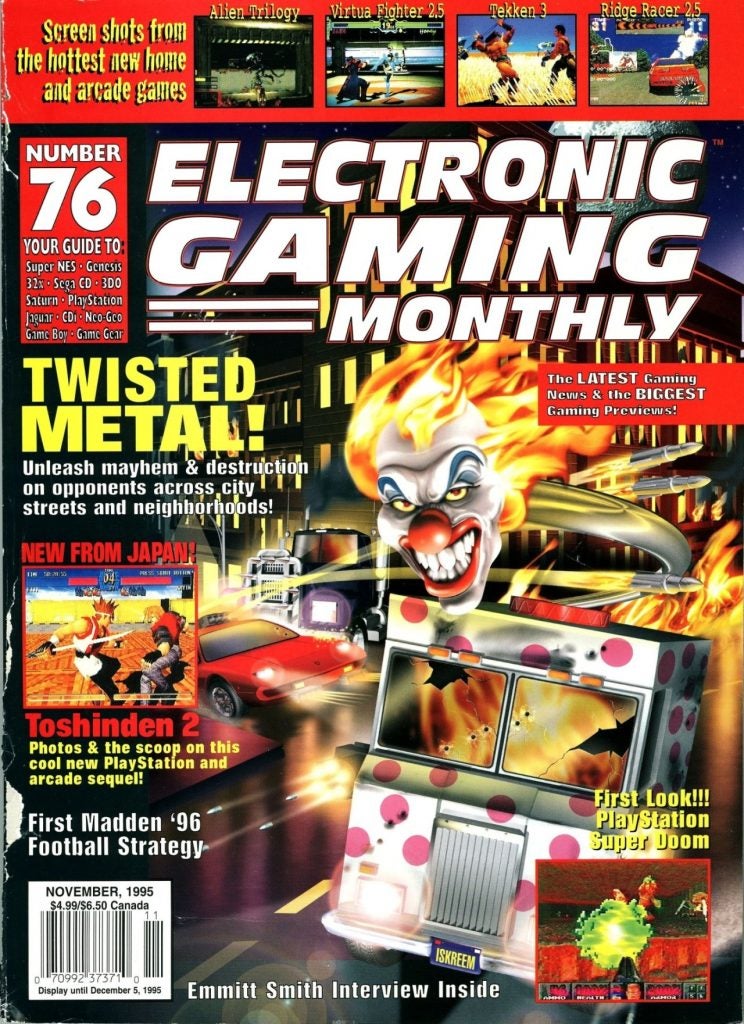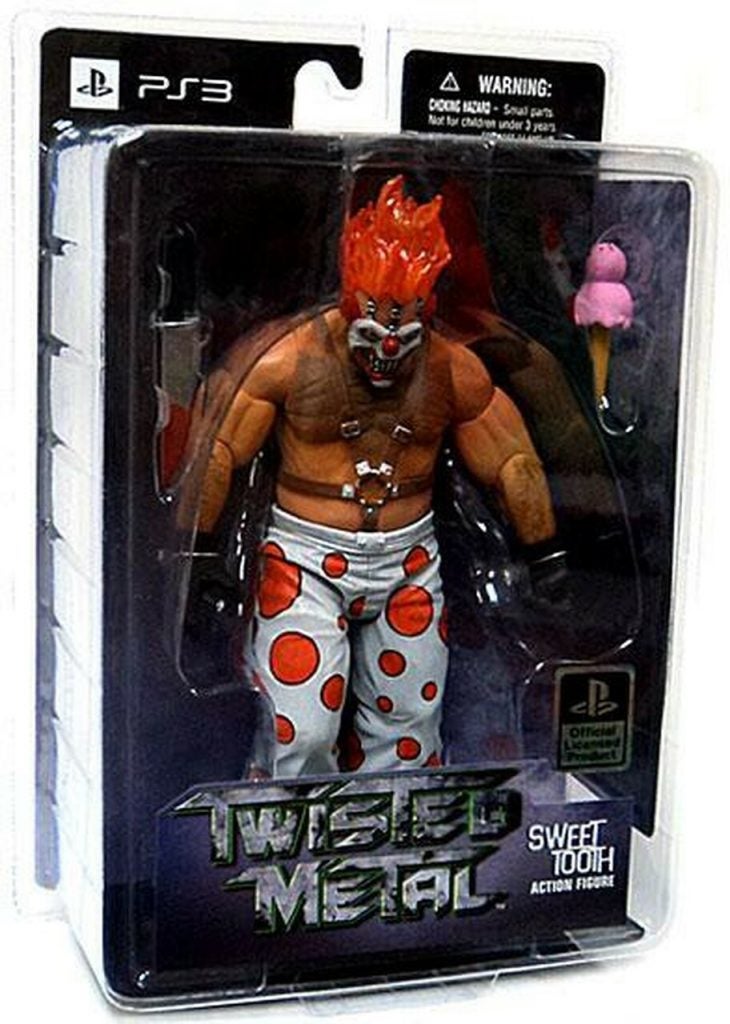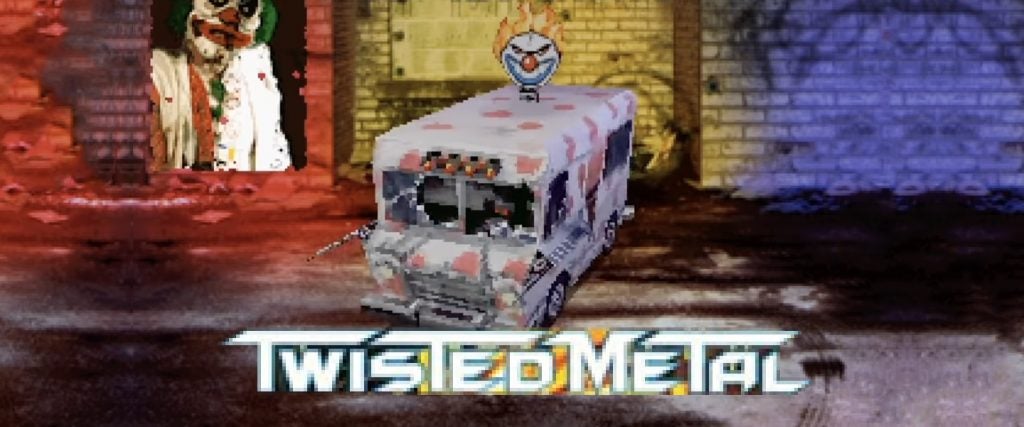It’s Christmas Eve 2005, and you’re driving around the warehouse district of Downtown L.A. The streets are deserted save for a few other cars roaming the neighborhood, all of which are decked out with machine guns ready to fire at you. Suddenly, you turn the corner, and there it is — the deadliest vehicle on the road. It’s an ice cream truck that fires flaming ice cream cones and is topped by the grinning face of an evil clown with fire for hair. It’s “Sweet Tooth,” and he’s shot his dreaded “Napalm Cone” at you, which means you’re already dead.
Fortunately, it’s really only 1995, and all you and your friend have to do is go back to the game menu and start another round of Twisted Metal, the coolest, most ridiculously over-the-top new game of the year.
Often described as “Mortal Kombat with cars,” Twisted Metal was basically a demolition derby where players drove around in 3D cars with all sorts of other crazy weapons. It was one of the very first games to appear on the original PlayStation console, debuting November 5, 1995. The game was crude, clunky, far too short and also kind of ugly. Not surprisingly then, internal expectations were low at Sony about how successful Twisted Metal would be. To everyone’s surprise though, it became a monster hit, being named “Game of the Year” by Electronic Gaming Monthly and selling over a million copies.
In the years since, Twisted Metal has spawned over a half-dozen sequels, Sweet Tooth has become a gaming icon and an adaption for television has gone into development. But it all started with a simple idea from video game designer David Jaffe, when he and his co-developer Mike Giam were stuck in some mind-numbing L.A. traffic.
The Road to ‘Twisted Metal’
David Jaffe, Co-Creator and Co-Designer of Twisted Metal: I started at Sony in 1993 as a game tester. I was living in Los Angeles, making some of my own movies, and I’d actually gotten a couple of TV shows optioned. Like an idiot, I thought that meant they’d get made, so I figured I’d work as a game tester until those came through. When I was hired, I was testing terrible Sony games based on movies like Cliffhanger and Last Action Hero and this Ray Liotta film called No Escape.
I’m an ambitious, driven guy though, and in video games, I saw the ability to express the same kind of creativity that I wanted to express in TV and movies. So I decided that I wanted to tell a story in a game and that became my goal. Very quickly, I moved from testing to design and then from designing games to directing games.
Those games were for platforms like Super Nintendo, but during this time, Sony was developing the first PlayStation console, which would revolutionize gaming in a lot of ways. For one thing, the PlayStation would be the first time the public at large would be exposed to 3D gaming, which was very new at the time. Before then, people were playing all kinds of side-scrolling games like Sonic the Hedgehog and had no idea how to move an avatar around in a 3D space. The PlayStation also had its games on discs, which provided a lot more space, and which allowed developers to think more cinematically about the games and to tell bigger stories. Finally, when Sony began marketing the system, they weren’t doing it to kids, they were marketing it to an older audience like video games were the next big thing — like video games were an art form.
Toward the end of 1994, I just came off a game named Mickey Mania, which wasn’t a commercial hit, but it was a critical hit. It was a difficult production, though, because I was a real pain in the ass. I thought being a game designer was like being a movie director — or, at least, what I thought a movie director was supposed to be. I thought everyone showed up and just did what I told them to do. I had no understanding of the value of working as a team and collaboration and things like that. So my career was in jeopardy, and my boss basically told me that if things don’t turn around on my next project, I may be out of a job.
That’s where I was at when I was sent to Utah in late 1994 to visit a company called Evans & Sutherland — who were pioneers in the 3D graphics industry — to see if we wanted to work with them on some of the first PlayStation games. They had developed flight simulators and things like that for the military, and when I was there, I did all sorts of cool stuff like fly a fighter jet in a military simulator and experienced a futuristic city in early VR. The moment I’ll never forget is when I was flying around this ship on Mars and I saw this dome city floating in the background. I asked the Evans & Sutherland guys, “What’s that?” and they said, “Well, go check it out.” That’s when it clicked for me. The idea that the background was no longer just a background — it was a revelation.
Creating ‘Twisted Metal’
Jaffe: When we got back to California, Mike Giam [another designer at Sony Imagesoft], Allan Becker [a producer at Sony Imagesoft] and I were driving home on the 405 in heavy traffic. Even for L.A., it was terrible, and we were all annoyed at it. I don’t know if I said it or Mike said it or Allan said it, but one of us said that it would be great to have Mad Max weapons and just blow all these fucking cars away. In that moment, that’s where the idea was planted and we realized that would be a really cool game.
About three weeks later, there’s like 15 of us designers and producers sitting around a table at Sony Imagesoft, and one guy from marketing comes in named Peter Dilly. We’d already gotten our ideas cleared by Rich Robinson, the head of Sony Imagesoft, and now he wanted us to pitch our ideas to marketing. I had a bunch of different ideas, and when I got to what would become Twisted Metal, I said, “It’s called Battle Cars. It’s like Doom, but you’re in cars.” That’s all I said. Then marketing said, “Okay, go make that.” That’s how easy it was to get a game greenlit back then, which is nothing like it is today.
Scott Campbell, Producer on Twisted Metal: I was originally an engineer at Evans & Sutherland, then three guys broke off from Evans & Sutherland to form SingleTrac to make games with Sony. SingleTrac then cherry-picked other guys from the company, including myself. At the time, there were just barely enough of us to do two games, both of which would be launch titles for the PlayStation. They were Twisted Metal and Warhawk.
Jaffe: When things got going with both games, it was me and Mike Giam working with SingleTrac. There came a time though, where they needed one of us on one game and one of us on the other. I can’t remember, but I think we both wanted Twisted Metal, so it all came down to a coin toss, which I won. I picked the car combat game, and Mike Giam went to work on Warhawk, a flight-simulator game.
Campbell: From the start, Jaffe and I just clicked. We worked really well together. We all bonded as a team, and it was lots of fun. I had come from traditional engineering, so when I got into games, I had no idea you could make money while having so much fun.
Jaffe: Having come off my rocky experience with Mickey Mania, I made an effort to be more collaborative. Also, the SingleTrac guys, at the time, didn’t know gaming, so I could kind of call the shots on that while they handled the tech and told me what they could and couldn’t do.
Campbell: Our budget was $750,000, which was very low, and we had less than 11 months from concept to delivery. It was a ridiculous schedule. No one had ever done this before, so we had to figure out things that are really simple nowadays. Like, we had to figure out how to make a car drive like a car. That might not sound like much, but it couldn’t drive on all straight lines like a Tetris game, it had to move around like an actual car, which was new.
Jaffe: To figure Twisted Metal out, we played a ton of Mario Kart in battle mode and a ton of Doom. Fighting games were big in arcades at the time, and we looked to Mortal Kombat in terms of the tone and the idea of the characters. We wanted the cars to be characters, and from that, we developed the idea that the cars were all competing in this competition held by a character named Calypso. Calypso was this evil genie who would grant them any wish they desired, and each character was given their own story. The genie bit was cliché, I guess, but it seemed like a good premise for a car combat game, as opposed to coming up with some real deep logic behind it.
Lee R. Wilson, Vehicle and Character Designer on Twisted Metal: I designed the cars and the characters in the first game. Really, it was David’s ideas, but David couldn’t draw; so he’d give me some ideas and I’d come back with a bunch of options. I worked on most of the Twisted Metal games, and the direction given to me by David was always, “More sick and twisted.”
Jaffe: We had a lot of trouble coming up with the names for the cars. Then, one day, my girlfriend, who later became my wife, saw a poster of the cars and said, “That’s Yellow Jacket. That’s Darkside. And that’s Sweet Tooth.” They were great names. Even today, when I’m working on something, I’ll ask her for help with naming stuff.
Sweet Tooth, of course, is the most famous character. He came about because we kept coming back to this movie Stephen King directed called Maximum Overdrive, where a semi-truck had the Green Goblin’s face on it. That spawned the idea of an ice cream truck with a clown on it. Because that car had a face on it, marketing chose that car for the cover. That’s basically how he became the mascot of the franchise.

Because every character had their own story, they each had an ending if they won the contest. For them, I filmed these very Troma-esque, B-movie type endings — but even calling them a “B movie” is being a little bit generous.
Campbell: I remember we spent $80,000 on all the endings, and at SingleTrac, they were saying “These are terrible!” They were so cheesy! I didn’t mind the cheesiness, but a lot of people didn’t like them.
Jaffe: I wasn’t trying for that vibe. I was genuinely trying to make interesting little Twilight Zone-type stories for each character, with a “be careful what you wish for” twist to it. But Sony thought they were terrible, so they cut all the endings from the game. Years later, the endings would surface online and fans would love them, but they’re terrible.
We got the name Twisted Metal really late in the process. Battle Cars was a placeholder name because there was already a Super Nintendo game named Battle Cars. Then it became Urban Assault, but Microsoft already had a game with that name. Then it became High Octane, but we couldn’t get that either. For a while, I liked Cars and Rockets, but eventually, this consultant producer named Andy Sells came up with the name Twisted Metal. I didn’t love it, but later on, I’d realize titles don’t matter. It’s what’s in the game that matters.
Campbell: There were a few other last-minute changes made to the game, too. For starters, the levels were originally one big, Grand Theft Auto-type map, but we broke it up into four different levels to extend gameplay. Also, the split-screen multiplayer was very much an afterthought. It was a contractual obligation from Sony, so it was always going to be in the game, but we didn’t think much about it until toward the end, when I assigned it to two engineers and one graphics modeler. Surprisingly, the multiplayer became one of the real strengths of the game.
Jaffe: We didn’t even think about the multiplayer, but once it was in there, we realized, “Oh shit! This is really fucking fun!” That saved the game because that’s how most people remember playing it — as a split-screen with their friends.
‘Twisted Metal’ Hits the Shelves
Jaffe: The reaction at E3 [the video game trade show] was really good, but other games like Wipeout and Ridge Racer got most of the attention. I think that was because 3D games were so new that the better-looking games did better. Twisted Metal is not a pretty game.
Kellan Hatch, Creative Director at SingleTrac during Twisted Metal: A game like Crash Bandicoot could look beautiful because they put all their money right in front of the camera. It wasn’t an open world, so they controlled what you see. With Twisted Metal, we had to build everything, and the graphics suffered for it. I remember when we showed the Sony executives in Japan the finished game, the first question they asked was, “When are you going to replace the little boxes with cars?”
Jaffe: At E3, we weren’t the homecoming queen, but it went well. That all got shot to shit, however, when we brought Twisted Metal to a focus group. The focus group hated it. They couldn’t stand Twisted Metal, and they just loved Warhawk. They said Twisted Metal was stupid. I even remember calling my wife and saying that I’m going to have to find a new job because I thought it was going to fail. But then it came out and worked. It really worked. People bought it in droves, and it got game of the year from Electronic Gaming Monthly.

Justin Cioli, Founder of the Twisted Metal Fan Club Facebook Page: I was eight years old when my dad got me the first game. It was one of the first games I ever played, and it quickly became my favorite. I just loved everything about it. Even the soundtrack to those games were great. Twisted Metal got me into rock and metal music.
Campbell: Part of the reason why it worked so well — even with limited graphics and only okay controls — was because 3D was so new that we got a lot of points for that. The gameplay was compelling and the universe had this grungy look, so people adopted early and stuck with it.
Jaffe: Then they made sequel after sequel after sequel.
A Twisted Legacy
Ghenry Perez, Video Game YouTuber, Twisted Metal Fan: After the first game, Twisted Metal II came out the next year. Most people think the franchise took a step back with Twisted Metal III and Twisted Metal 4, which David Jaffe wasn’t a part of. Jaffe then came back for my favorite game, Twisted Metal: Black, which scared the hell out of me when I was 11 because it was super dark and Sweet Tooth became a serial killer and the stories were really in-depth.
There was also Twisted Metal: Small Brawl, which was a kids version. Then there was Twisted Metal: Head-On in 2005 and another game in 2012 just called Twisted Metal. Most people regard Twisted Metal II and Twisted Metal: Black as the best in the series. They haven’t announced anything yet, but since they’re making a new TV show, a lot of people think they’re working on a new one.
Sweet Tooth has also been featured in a few other PlayStation games like PlayStation All-Stars Battle Royale. There’s also toys of Sweet Tooth and other stuff with him, so Sony is still aware of him, even without a new game in the last 10 years. Fans have stuck with it too. There have been a number of ups and downs in the franchise, but people like me have stuck with Twisted Metal because it was a part of their childhood.

Jaffe: I do a lot of streaming now, and I have people three or four times a week tell me, “Thank you guys for my childhood.” A lot of it is the right time at the right place, but it’s pretty cool so see.
Hatch: I was one of those skeptical people too when that first game was coming out. I was a bit embarrassed by how it looked, and I didn’t think there was enough to the game — it was just driving and shooting. I thought there had to be more. But it succeeded for one simple reason — it was fun. That’s all it needed to be.

